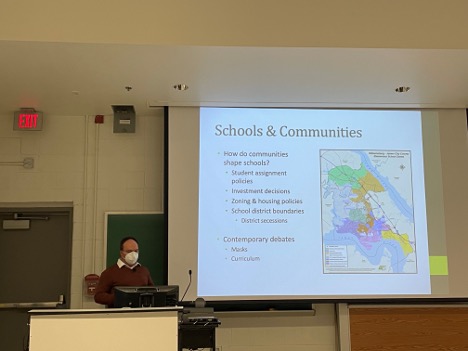National expert on school choice and race visits Public Policy
 William & Mary’s Public Policy Program and the School of Education recently partnered in welcoming to campus Professor Deven Carlson, the Associate Director for Education at the National Institute for Risk and Resilience and Presidential Research Professor at the University of Oklahoma. Prof. Carlson is one of the nation’s leading experts on school choice and its implications for racial segregation and school performance. During his two-day visit on February 21-22, Prof. Carlson was a guest in Prof. Paul Manna’s education policy and politics seminar, he met with leaders of the African American Male Coalition, and also gave a research talk to faculty and students at the School of Education.
William & Mary’s Public Policy Program and the School of Education recently partnered in welcoming to campus Professor Deven Carlson, the Associate Director for Education at the National Institute for Risk and Resilience and Presidential Research Professor at the University of Oklahoma. Prof. Carlson is one of the nation’s leading experts on school choice and its implications for racial segregation and school performance. During his two-day visit on February 21-22, Prof. Carlson was a guest in Prof. Paul Manna’s education policy and politics seminar, he met with leaders of the African American Male Coalition, and also gave a research talk to faculty and students at the School of Education.
The capstone event of his visit was an evening public lecture entitled “School Choice & Diversity in the U.S.: How Race, Politics, and Values Influence Policy and Shape Communities.” He addressed several key themes in that lecture.
Key Policy Tensions
In his lecture, Prof. Carlson described how historically, communities have used the political process to maintain segregated schools through federal policies and legal action, aspects that are still relevant today when discussing school choice. School choice operates in many forms, and to further evaluate the importance of school choice and its growing influence, Prof. Carlson examined the reciprocal relationship between schools and communities and how they interact with one another. The dynamic relationship highlights that communities shape schools through student assignment policies, investment decisions, and zoning, while schools shape communities through educational options and demographics. With contemporary debates such as mask requirements and school curricula trying to shape schools, it is crucial to address how communities use policy choices to leverage the political process to shape their schools. 
As Carlson noted, when looking at school diversity and choice within a contemporary context, it is essential to evaluate various school choice options such as magnet schools, inter-district open enrollment, charter schools, and private school vouchers. Community efforts to diversify schools continue to encounter significant political opposition, questioning whether increasing school choice is an asset, liability, or both. To dive further into this question, Prof. Carlson looked at school choice within and outside of a traditional schooling system to compare how choice operates differently between them. The traditional system setup involves school choice within diversity-desiring districts that aim to achieve diversity through voluntary parental choices such as intra-district choice and magnet programs. However, the choices may work against diversity goals due to the freedom of families choices that could potentially detract from achieving diversity goals. However, achieving diversity through choices outside of the traditional public school system, such as private and charter school vouchers, would break the link between family residential location decisions and schooling options, essentially diversifying schools. Depending on families’ choices, steering away from a traditional public school system could provide families with the option to further segregate schools.
Research on Wake County
Further, regarding how school choice operated within diversity-desired districts, Prof. Carlson discussed the case of the Wake Country Public School system (WCPSS), a system formed by the merger of a majority-black city district and a majority-white county district. WCPSS transitioned to a student assignment policy that set diversity goals based on socioeconomic status (SES) and student achievement to implement race-neutral assignment policies. Prof. Carlson’s research found that while WCPSS achieved its diversity goal of having an SES balance, it did not necessarily achieve racial/ethnic diversity. Furthermore, choice options generated political sustainability for the diversity initiative in WCPSS, but reassignment was still required, and the district could not achieve goals through parental decisions alone. That being said, choice options may work against diversity goals as families can opt out of base schools. For WCPSS, specifically, many white families opted out of their assigned base school when that school did not have their desired demographic representation of themselves, but the research found that this sensitivity was not relevant among Hispanic and Black students. The case of WCPSS showcases that specific school choice options can encourage school integration (magnet schools), but other options can work against diversity goals (year-round schooling options).
Conclusions about Policy Design
Despite the challenging political and legal environments for districts when trying to achieve diversity, the future of the dynamic relationship between school choice and diversity opens opportunities both within and outside traditional systems. Policy design will continue to play a significant role in diversifying schools through diverse-by-design charter schools, organized support, various strategies, and even housing policies related to zoning. According to Professor Carlson, education is a collective endeavor, and schools should be the best reflection of communities, emphasizing the importance of choice. How we think about writing policies regarding school types will play a greater role in determining diversity efforts than other forms of choice.
* * *
The Public Policy Program would like to its partners at the School of Education, especially Profs. Janise Parker and Pamela Eddy, for helping to make Prof. Carlson’s visit such a success. And many thanks to Prof. Carlson for taking time to share his wisdom with us at William & Mary!















